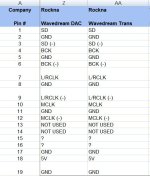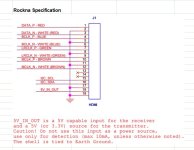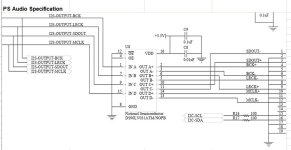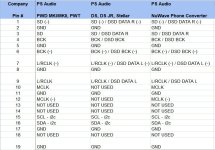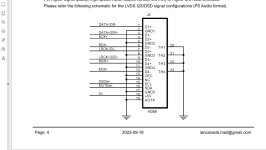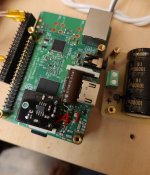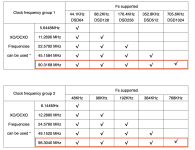I have some questions about i2s format across the different versions of the HDMI Transmitter.
I started with HDMI Transmitter MK1 and I was using PS Audio format on my DAC (a Rockna Wavedream supporting 2 formats: PS Audio and Rockna which can be changed in the software menu - I also use a Viablue HDMI cable which I do not think reverses any pin).
I moved to HDMI Transmitter MK2 and I noticed I have the L/R reversed so I have changed to Rockna format and did not give it much thought.
Now my las move was upgrading to HDMI PRO on which also Rockna format works with correct L/R. Noticed that another user on this forum made detailed tests and found out that also phase issues may occur using the wrong format. So I have checked the user manual for HDMI PRO where the PS Audio is specified as the format used.
So I am a bit confused. Which format is actually used with HDMI PRO? Was the format changed across models (it surely looks like as no software update was performed on the Rockna in the mean time)?
Source of the info is a document found online and done by Sonore:
https://docs.google.com/spreadsheets/d/1h5PMUBkldkpt1rCnAR4ZHYGZNeCe-vwIFyKWYMZWsX0/htmlview#
I started with HDMI Transmitter MK1 and I was using PS Audio format on my DAC (a Rockna Wavedream supporting 2 formats: PS Audio and Rockna which can be changed in the software menu - I also use a Viablue HDMI cable which I do not think reverses any pin).
I moved to HDMI Transmitter MK2 and I noticed I have the L/R reversed so I have changed to Rockna format and did not give it much thought.
Now my las move was upgrading to HDMI PRO on which also Rockna format works with correct L/R. Noticed that another user on this forum made detailed tests and found out that also phase issues may occur using the wrong format. So I have checked the user manual for HDMI PRO where the PS Audio is specified as the format used.
So I am a bit confused. Which format is actually used with HDMI PRO? Was the format changed across models (it surely looks like as no software update was performed on the Rockna in the mean time)?
Source of the info is a document found online and done by Sonore:
https://docs.google.com/spreadsheets/d/1h5PMUBkldkpt1rCnAR4ZHYGZNeCe-vwIFyKWYMZWsX0/htmlview#
Attachments
What Greg said. More details, power supply requirements, measured phase noise, sonics or sound?Can't wait!
Put up for sale some Ian Canada parts (mainly I/V stuff) for sale:
https://www.diyaudio.com/community/threads/ian-canada-parts-for-sale.397025/
https://www.diyaudio.com/community/threads/ian-canada-parts-for-sale.397025/
Better SQ then the Accusilicon??SC-CUT-kristallen. 45,1584 MHz. Geweldige faseruisprestaties.
SC-CUT_Crystals door Ian , op Flickr
Ian
Great, as in proven better than usual Crystek and Accusilicon ones?
But seriously, Jan.
From my experience with Q3, I can say that connecting a separate power supply even to stock accusilicon in a small case gives a very good result.
I looked at the specifications of the laptechs clocks. I don't know what kind of crystals were made for you, but at 25 Mhz with low noise generators among their models are - in the region of 115-120 Db at 10 Hz. Which is a very high result (This is already close to limiting the other components in the rest of the streamer).
Your new Q7 is a great product, a worthy result of 10 years of work. I made a comparison by connecting to it stok RaspberryPi 3b and RaspberryPi 3b (Where I not only removed the pmic by making 1.8v 3.3v through separate linear regulator , but also removed the antenna, Wifi, Bluetooth with their clock and replaced the clock with 19.2 MHz from a separate PSU and achieved stable launch). I will attach a photo of my raspberry.
Very good! What can not be said about FifoPiQ3.
In this case, are you planning to make it possible for your clocks to connect a separate power supply from fifo board? So that you don't have to solder anything too much?
Attachments
Last edited:
Hello,
Can only give you some hint clock,I prefer better than both Accusilicon and Crystek. And are not going to cost you a arm and a leg🙂.https://www.aliexpress.com/item/1005001292169859.html
Can only give you some hint clock,I prefer better than both Accusilicon and Crystek. And are not going to cost you a arm and a leg🙂.https://www.aliexpress.com/item/1005001292169859.html
AIRAIR, I have made same as you removed that switched chip and make separate 3,3v and 1,8. Going also to replace clock 19,2mhz with Oxco.Have one question,where can you find clock bluetooth and antenna wifi. I only now about common clock for ethernet and usb on 3B.
In this case, you have a different model, I have 3b. It is the most suitable, the first in the line for 64bit, i.e. any software with good sound is supported and has only 1 quartz at 19.2I only now about common clock for ethernet and usb on 3B.
Quartz at 25 MHz is changed to XO and switches before raspberries, it makes no sense to add one more.
In 3b chip for wifi and bluetooh marking U19 and near his quartz Х2. Antenna on on the other side with the edge between the gpio and lcd socket.
Just for clarification, I have Raspberry 3B Version 1.2 and I agree most suitable.Run it with Volumio 3...... and plugin music shield,put the tasks for music on dedicated cores.You can see my buildt on post 8325,put in some pictures and information.Maby some misspelling my english or yours,25mhz shared ethernet and usb,19,2mhz for music. Clock for bluetooth?
Last edited:
Any more info? How does it compare to the discontinued Pulsar Clock?
https://www.diyaudio.com/community/threads/pulsar-clock-ultra-low-noise-ocxo.258789/
Q7 accepts 90/98Mhz clocks or just 45/49Mhz? According to doc it's a NO, max 89Mhz but I'm somewhat confused, I'm hoping there's someone with actual experience.
Thx.
Thx.
@iancanada my 9038q2m dac hat is doing something strange with the power. When I have power only connected to DVCC, the VCAA red light comes on and I read about 2.2v of power to VCAA even though no power is connected. AVCC reads about 100mv but no light comes on. When I connect power from three separate supplies to DVAA, VCAA and AVCC everything works but it doesn't seem like the power supplies are truly separated.
Also, I know FIFOPI q7 supports clocks down to 5xx, but just saw that 9038q2m dac supports starts at 22xxx. If you use clocks on FIFOPI q7 with the dac hat will clocks below 22xxx work?
Also, I know FIFOPI q7 supports clocks down to 5xx, but just saw that 9038q2m dac supports starts at 22xxx. If you use clocks on FIFOPI q7 with the dac hat will clocks below 22xxx work?
Update: Seems that the ESS controller is causing the power supplied be slightly bridged. When the ESS controller is plugged into the dirty side of FIFOPI I believe it's causing a small bridge to VCAA. With DVCC, VCAA and AVCC unconnected, when I turn power on VCAA reads 1.9v. If I add power to DVCC, power on VCAA goes up to 2.4v. When I remove the controller, everything measures zero.
@iancanada as a follow-up how can I set the DAC to remain at full volume without the ESS controller? When I replace the controller with monitorpi I lose volume. Monitorpi shows lock and that it is unmuted but I can't get any sound. Thank you.
- Home
- Source & Line
- Digital Line Level
- Asynchronous I2S FIFO project, an ultimate weapon to fight the jitter
